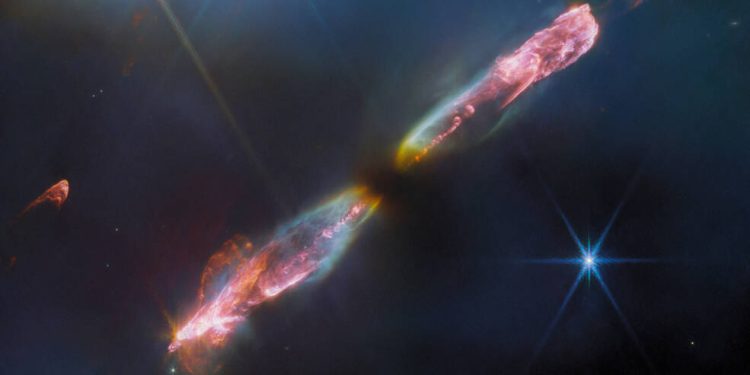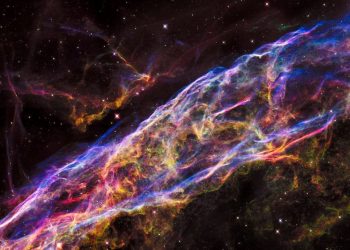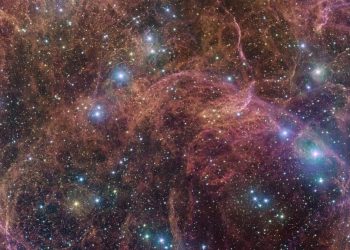In the distant reaches of space, far beyond our Milky Way, astronomers have made a fascinating discovery. A group of massive stars, breaking free from their birth clusters in a nearby satellite galaxy, are racing through the cosmos at incredible speeds. This unexpected exodus could reveal that such runaway stars play a much larger role in the universe’s evolution than we once thought.
The Birth of Runaway Stars
As explained by Science News, stars are born in tightly packed stellar nurseries, where gravitational forces keep them clustered together. In some cases, close encounters between massive stars or the violent force of a nearby supernova can fling a star out of its home cluster, sending it hurtling across space. These stellar refugees, known as runaway stars, venture far beyond their original galaxies, influencing their surroundings as they go.
A recent study led by astronomer Mitchel Stoop offers new insights into this phenomenon. Using data from the Gaia spacecraft, Stoop and his team focused on a massive star cluster known as Radcliffe 136 (R136), located approximately 170,000 light-years away in the Large Magellanic Cloud, a small galaxy that orbits the Milky Way. Their research uncovered an astonishing number of runaway stars—far more than anyone had predicted.
A Closer Look at R136
R136 is no ordinary star cluster. It’s home to some of the most massive stars in the universe, ranging from five to 140 times the mass of our Sun. What makes this cluster particularly interesting is its clear visibility from Earth, allowing astronomers to study its contents in detail.
In previous studies, scientists identified a few runaway stars escaping from R136. But Stoop’s wider search revealed that a staggering 55 stars had fled the cluster at breakneck speeds, some reaching over 100,000 kilometers per hour. These stars were ejected over the last three million years, with many departing in all directions around 1.8 million years ago during the cluster’s formation.
This discovery has sparked new discussions among astronomers about the role these stars may have played in shaping not just their home galaxies but also the broader universe.
The Hidden Power of Runaway Stars
Runaway stars, particularly the massive ones, carry a tremendous amount of energy. They emit powerful ultraviolet radiation and generate stellar winds that sculpt the gas and dust around them. When these stars eventually explode as supernovae, they scatter heavy elements across galaxies, fueling future star and planet formation.
In the past, these stars were largely overlooked in simulations of cosmic evolution because they were thought to be rare. However, if clusters like R136 are losing up to a third of their most massive stars, the potential impact of these cosmic wanderers could be far greater than we ever imagined.
One intriguing theory is that runaway stars may have contributed to a significant event in the early universe known as reionization. Roughly 13 billion years ago, ultraviolet radiation stripped electrons from hydrogen atoms, lifting the universe out of its “cosmic fog.” While most scientists believe this radiation came from dwarf galaxies, Stoop suggests that runaway stars could have been a hidden source of these crucial photons.
Could Runaway Stars Shape the Early Universe?
While runaway stars are certainly an important piece of the cosmic puzzle, the exact extent of their influence remains unclear. Astrophysicist Sally Oey of the University of Michigan acknowledges their significance but points out that other mechanisms could have also contributed to the spread of ionizing radiation during reionization.
Another intriguing aspect of Stoop’s findings is the unusual timing of some of the star escapes. While most runaways left the cluster early on, a group of 16 stars fled around 200,000 years ago, all in the same direction. This peculiar behavior may have been triggered by a merger between R136 and another cluster, leading to a secondary ejection event. If this pattern proves to be rare, it could complicate efforts to understand how common such stellar migrations are in other parts of the universe.
Looking to the Future
The discovery of these runaway stars opens the door to a deeper understanding of the forces shaping the universe. As astronomers continue to study R136 and other clusters like it, they hope to uncover more about how these stars influence the evolution of galaxies and intergalactic space. The next steps will involve finding similar star ejections in other clusters to determine whether this phenomenon is unique to R136 or if it’s more widespread.
With each new finding, we inch closer to unraveling the mysteries of our universe—and runaway stars may be one of the keys to unlocking that knowledge.











